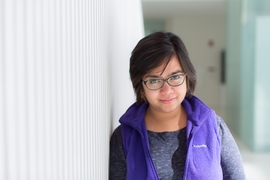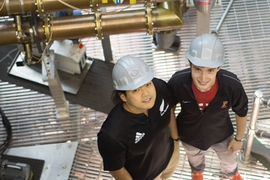The Department of Nuclear Science and Engineering's 2016 Graduate Research Expo was held on March 11, kicking off MIT’s visit weekend for prospective graduate students. The event provides a unique opportunity for visitors and MIT community to learn more about the diverse research being conducted within the Department of Nuclear Science and Engineering (NSE) by faculty and graduate students. Topics in the 2016 Expo ranged from developing new algorithms for efficient computational modeling of reactors to characterizing the heat transfer at the clad-coolant interface, to modeling the material properties of molten salt coolants for advanced reactor designs. The breadth of projects captured the interdisciplinary nature of nuclear science and engineering, which sits at the intersection of material science, mechanical engineering, physics, and computer science. In all, 22 students participated the expo, including Alexandre Guion, Brandon Sorbom, and Lixin Sun, who spoke about their research along with a poster session.
Microscale boiling and heat transfer
In his presentation entitled “New understanding in microscale boiling phenomena: moving contact lines and microlayer formation,” Alexandre Guion described his work on a coupling experimental and computational modeling to understand the details of boiling — a critical problem in nuclear energy. His approach is to study the growth of liquid microlayers and their impact on heat transfer in reactor fuel elements. Guion's research seeks to accurately model the time-evolution of the liquid microlayer as a bubble forms, expands, and departs from a surface and enable more-efficient heat transfer at higher temperatures.
Fusion energy, accelerated
Brandon Sorbom’s presentation, “I feel the need ... the need for speed: Using particle accelerators to achieve faster fusion materials research,” discussed work being conducted at MIT’s Plasma Science and Fusion Center (PSFC) on new superconducting magnets that are being used to advance fusion energy research and the use of particle accelerators to achieve faster fusion materials research.
The achievable fusion power of a reactor scales with magnetic field strength to the fourth power, hence small improvements in magnets can yield large increases in reactor power. Together with colleagues at the PSFC, Sorbom designed a new affordable, robust, compact reactor that utilizes advances in high-temperature superconductors to increase the magnetic field strength and thereby improve plasma performance while keeping the fusion reactor size — and, more importantly, cost — manageable.
Beyond the reactor: Microstructures of reducible oxide materials
Lixin Sun’s presentation focused on the computational modeling of point defects in oxide lattices and assessing their impact on oxygen conductivity in the neighborhood of defect sites decreasing the performance of devices in which the material is used. In a talk entitled “Dig deep into microstructure: a computational perspective on extended defects in reducible oxide materials,” Sun likened defects to traffic jams in mass transport. While their size is small, their impact can hinder mass transport across a wide area.
Similarly, materials that have high defect densities can have poor bulk oxygen conductivities, resulting in poor device performance. Sun’s work in modeling the impact of different cation dopants in a metal oxide lattice shows how understanding of materials at the micro-scale can inform the design of bulk materials for devices used in systems to support advanced nuclear reactors.









